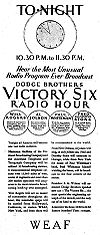
The Dodge Victory Hour
Encyclopedia

The show starred Will Rogers
Will Rogers
William "Will" Penn Adair Rogers was an American cowboy, comedian, humorist, social commentator, vaudeville performer, film actor, and one of the world's best-known celebrities in the 1920s and 1930s....
, Paul Whiteman
Paul Whiteman
Paul Samuel Whiteman was an American bandleader and orchestral director.Leader of the most popular dance bands in the United States during the 1920s, Whiteman's recordings were immensely successful, and press notices often referred to him as the "King of Jazz"...
and his orchestra, Fred Stone
Fred Stone
Fred Andrew Stone was an American actor. Stone began his career as a performer in circuses and minstrel shows, went on to act on vaudeville, and became a star on Broadway and in feature films, which earned him a star on the Hollywood Walk of Fame.-Biography:He was particularly famous for appearing...
and Al Jolson
Al Jolson
Al Jolson was an American singer, comedian and actor. In his heyday, he was dubbed "The World's Greatest Entertainer"....
in a 47-station coast-to-coast program with Jolson in New Orleans, Stone in Chicago and Whiteman in New York. From his home in Beverly Hills, Will Rogers did a Coolidge imitation, the first time a President was imitated on radio.
Sponsored by Dodge's new Victory Six automobile, the program reached an audience estimated at 35 million, the largest since Charles Lindbergh
Charles Lindbergh
Charles Augustus Lindbergh was an American aviator, author, inventor, explorer, and social activist.Lindbergh, a 25-year-old U.S...
's return in 1927. The following day, The New York Times
The New York Times
The New York Times is an American daily newspaper founded and continuously published in New York City since 1851. The New York Times has won 106 Pulitzer Prizes, the most of any news organization...
headlined: "All America Used As a Radio Studio".
Two months later came a follow-up. The second Dodge Victory Hour was broadcast in March 1928, once again with Hollywood stars and Whiteman's band. To reach an even larger audience, United Artists installed extra speakers in theaters.

